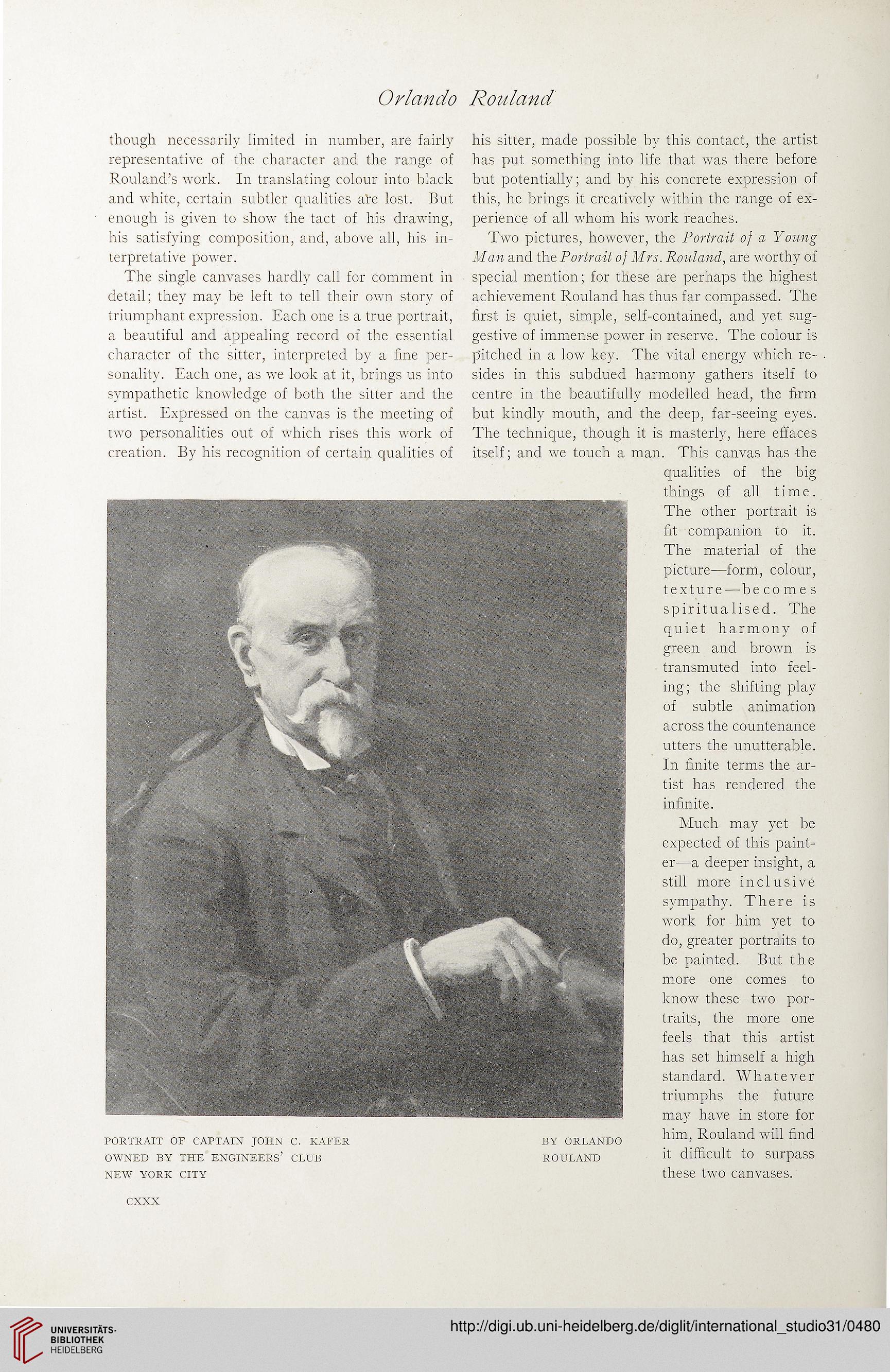Orlando Rouland
though necessarily limited in number, are fairly
representative of the character and the range of
Rouland’s work. In translating colour into black
and white, certain subtler qualities ale lost. But
enough is given to show the tact of his drawing,
his satisfying composition, and, above all, his in-
terpretative power.
The single canvases hardly call for comment in
detail; they may be left to tell their own story of
triumphant expression. Each one is a true portrait,
a beautiful and appealing record of the essential
character of the sitter, interpreted by a tine per-
sonality. Each one, as we look at it, brings us into
sympathetic knowledge of both the sitter and the
artist. Expressed on the canvas is the meeting of
two personalities out of which rises this work of
creation. By his recognition of certain qualities of
his sitter, made possible by this contact, the artist
has put something into life that was there before
but potentially; and by his concrete expression of
this, he brings it creatively within the range of ex-
perience of all whom his work reaches.
Two pictures, however, the Portrait of a Young
Man and the Portrait of Mrs. Rouland, are worthy of
special mention; for these are perhaps the highest
achievement Rouland has thus far compassed. The
first is quiet, simple, self-contained, and yet sug-
gestive of immense power in reserve. The colour is
pitched in a low key. The vital energy which re-
sides in this subdued harmony gathers itself to
centre in the beautifully modelled head, the firm
but kindly mouth, and the deep, far-seeing eyes.
The technique, though it is masterly, here effaces
itself; and we touch a man. This canvas has -the
qualities of the big
things of all time.
The other portrait is
fit companion to it.
The material of the
picture—form, colour,
texture—becomes
spiritualised. The
quiet harmony of
green and brown is
transmuted into feel-
ing; the shifting play
of subtle animation
across the countenance
utters the unutterable.
In finite terms the ar-
tist has rendered the
infinite.
Much may yet be
expected of this paint-
er—a deeper insight, a
still more inclusive
sympathy. There is
work for him yet to
do, greater portraits to
be painted. But the
more one comes to
know these two por-
traits, the more one
feels that this artist
has set himself a high
standard. Whatever
triumphs the future
may have in store for
him, Rouland will find
it difficult to surpass
these two canvases.
PORTRAIT OR CAPTAIN JOHN C. KAFER BY ORLANDO
OWNED BY THE ENGINEERS’ CLUB ROULAND
NEW YORK CITY
CXXX
though necessarily limited in number, are fairly
representative of the character and the range of
Rouland’s work. In translating colour into black
and white, certain subtler qualities ale lost. But
enough is given to show the tact of his drawing,
his satisfying composition, and, above all, his in-
terpretative power.
The single canvases hardly call for comment in
detail; they may be left to tell their own story of
triumphant expression. Each one is a true portrait,
a beautiful and appealing record of the essential
character of the sitter, interpreted by a tine per-
sonality. Each one, as we look at it, brings us into
sympathetic knowledge of both the sitter and the
artist. Expressed on the canvas is the meeting of
two personalities out of which rises this work of
creation. By his recognition of certain qualities of
his sitter, made possible by this contact, the artist
has put something into life that was there before
but potentially; and by his concrete expression of
this, he brings it creatively within the range of ex-
perience of all whom his work reaches.
Two pictures, however, the Portrait of a Young
Man and the Portrait of Mrs. Rouland, are worthy of
special mention; for these are perhaps the highest
achievement Rouland has thus far compassed. The
first is quiet, simple, self-contained, and yet sug-
gestive of immense power in reserve. The colour is
pitched in a low key. The vital energy which re-
sides in this subdued harmony gathers itself to
centre in the beautifully modelled head, the firm
but kindly mouth, and the deep, far-seeing eyes.
The technique, though it is masterly, here effaces
itself; and we touch a man. This canvas has -the
qualities of the big
things of all time.
The other portrait is
fit companion to it.
The material of the
picture—form, colour,
texture—becomes
spiritualised. The
quiet harmony of
green and brown is
transmuted into feel-
ing; the shifting play
of subtle animation
across the countenance
utters the unutterable.
In finite terms the ar-
tist has rendered the
infinite.
Much may yet be
expected of this paint-
er—a deeper insight, a
still more inclusive
sympathy. There is
work for him yet to
do, greater portraits to
be painted. But the
more one comes to
know these two por-
traits, the more one
feels that this artist
has set himself a high
standard. Whatever
triumphs the future
may have in store for
him, Rouland will find
it difficult to surpass
these two canvases.
PORTRAIT OR CAPTAIN JOHN C. KAFER BY ORLANDO
OWNED BY THE ENGINEERS’ CLUB ROULAND
NEW YORK CITY
CXXX




